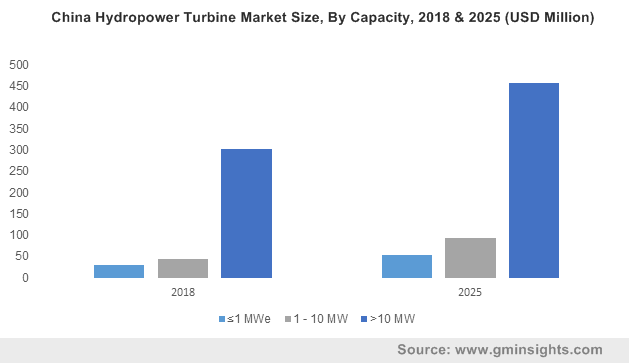Increasing number of power generation plants to favor hydropower turbine market share expansion
Publisher : Fractovia | Published Date : 2019-08-09Request Sample
The global hydropower turbine market size is expanding at an unprecedented rate owing to the increasing number of innovations in renewable energy sector. The growing usage of hydropower turbines in the power generation sector to replace the fast-depleting conventional energy sources will also fuel the industry outlook.
China Hydropower Turbine Market Size, By Capacity, 2018 & 2025 (USD Million)

Additionally, numerous initiatives are being undertaken by the government agencies to promote the usage and development of sustainable and efficient power sources. For instance, in April 2019, the United States Department of Energy (the U.S.) announced a grant of USD 54.2 million to facilitate development of hydropower, marine, and wind energy. Apart from setting aside sizeable funds, the regulations set by authorities to reduce carbon emissions while fulfilling the rapidly increasing demand for electricity is positively influencing hydropower turbine market share.
There has been a considerable increase in the number of establishments and storage of hydroelectric power plants worldwide. In this context, it is quite imperative to take note of the Attaqa power plant which is set to become the first power plant in Egypt that would generate electricity via water storage. The cost of the project apparently stands at USD 2.7 billion and it will commence operations by the year 2024. Reportedly, the facility will operate with two water reservoirs consisting of 7.3 million cubic meters of capacity, equipped with six 400 MW turbine units. Evidently, the construction of new hydropower projects across varied geographies is propelling the revenue scale of hydropower turbine industry.
When it comes to the product types existing in hydropower turbine market, the installations of reaction turbines have increased substantially over the last few years. According to reports, in 2018, these installations accounted for over 70% of the total hydropower turbine industry share. Reaction turbines are widely used in small and medium scale power plants owing to their highly efficient features and suitability for low heads applications (approximately 500 meters or less).
Another vital factor augmenting the growth prospects of hydropower turbine market is the rising demand for low head hydropower turbines that contribute to over 35% of the total market share. When compared to large hydro projects, these turbines require smaller impounded area thereby having less environmental impacts. They are widely used in areas where low head dams and other hydraulic structures exist for flood control, water regulation, and irrigation.
Various developing nations such as India and China are witnessing a growth in the number of small and medium scale hydro power plants due to considerable increase in governmental support for renewable energy sources. For instance, India’s Ministry of New and Renewable Energy has set up a ‘Small Hydro Power Program’ under which it aims to develop small hydro power plants of up to 25 MW capacities across the country. These small hydro plants are capable of improving the energy scenario of remote and inaccessible areas. Additionally, the Ministry aims at harnessing at least 50% of the hydro power potential in the country in the next 10 years.
Apart from India, China has emerged as an important growth terrain for the global hydropower turbine market. According to a study by International Hydropower Association, the hydropower electricity generation in China was recorded at 1,232,900 GWh in 2018. The country’s hydropower sector has grown twenty times with a total capacity of 352 GW. Additionally, strict norms laid by the government aiming at increasing the use of renewable resources is further driving the industry trends. For instance, by 2030, the National Development & Reform Commission of China aims at using 35% of its electricity from renewable sources. Thus, the growing hydropower sector in China is intensifying the demand for hydropower turbines.
U.S. hydropower turbine industry is expected to surpass 7MW of installations over the forecast period. The increase in investment towards upgradation and renovation of existing hydroelectric power plants coupled with the rising awareness regarding the benefits of renewable energies is shaping the U.S. hydropower turbine outlook. As per reports, the approximate hydropower generation in the US stood at 322,390 GWh last year. Several small-scale projects are being set up in the country such as the power plant being constructed at the Des Moines River in Iowa with a total capacity of 36.4 MW among many others.
Due to a rise in awareness among the nations with respect to climate change and its global impact, there has been a substantial shift towards the adoption of renewable sources of energy. Hence, the rise in usage of natural source of energy like hydroelectricity is driving hydropower turbine market trends. Moreover, major turbine makers along the likes of Toshiba, Cornell Pump, Kirloskar Brothers and General Electric are investing in turbine technology development which has opened up new business opportunities in the sector. According to a report by Global Market Insights, Inc., hydropower turbine market share is expected to surpass USD 2 billion by 2025.